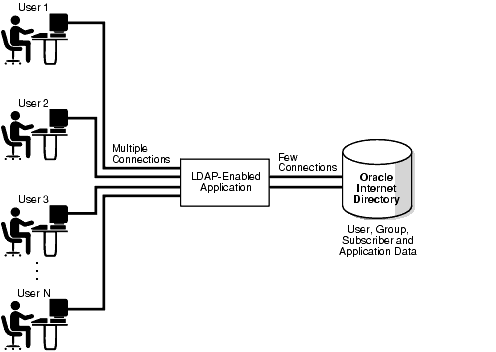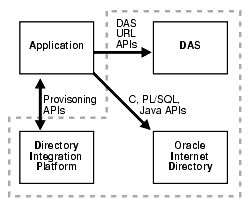10g (9.0.4)
Part Number B10461-01
Home |
Solution Area |
Contents |
Index |
| Oracle® Internet Directory Application Developer's Guide 10g (9.0.4) Part Number B10461-01 |
|
This chapter briefly describes the intended audience and components of Oracle Internet Directory Software Developer's Kit 10g (9.0.4). It also lists the other components of Oracle Internet Directory and the platforms it supports.
This chapter contains these topics:
Oracle Internet Directory SDK 10g (9.0.4) is intended for application developers using C, C++, and PL/SQL. Java developers can use the JNDI provider from Sun to access directory information in an Oracle Internet Directory server.
Oracle Internet Directory Software Developer's Kit 10g (9.0.4) consists of:
This section contains these topics:
Most directory-enabled applications are backend programs that simultaneously handle multiple requests from multiple users. Figure 1-1 shows how a directory is used in such environments.

As Figure 1-1 shows, when a user request needs an LDAP operation to be performed, the directory-enabled application performs the requested operation by using a smaller set of pre-created connections to Oracle Internet Directory.
Table 1-1 gives an overview of the typical directory interactions that an application makes during its lifecycle..
Application developers can integrate with Oracle Internet Directory by using the services and APIs listed and described in Table 1-2.
| Service/API | Description | More Information |
|---|---|---|
|
Standard LDAP APIs in C, PL/SQL and Java |
These provide basic LDAP operations. The standard LDAP API to be used in Java is the JNDI API with the LDAP service provider from Sun Microsystems. |
Chapter 2, "Developing Applications with Standard LDAP APIs" |
|
Oracle Extensions to Standard C, PL/SQL and Java APIs |
These APIs provide additional programmatic interfaces that model various Identity Management related concepts. |
Chapter 3, "Developing Applications with Oracle Extensions to the Standard LDAP APIs" |
|
Oracle Delegated Administration Services |
The Oracle Delegated Administration Services consist of a core self-service console and administrative interfaces that may be customized to support third-party applications. |
Chapter 6, "Developing Applications Integrated with Oracle Delegated Administration Services" "Oracle Delegated Administration Services", in Oracle Internet Directory Administrator's Guide |
|
Oracle Directory Provisioning Integration Service |
You can use the Oracle Provisioning Integration System for provisioning third-party applications, as well as as a means of integrating other provisioning systems. |
Chapter 4, "Developing Provisioning-Integrated Applications" "The Oracle Directory Provisioning Integration Service" in Oracle Internet Directory Administrator's Guide |
|
Oracle Internet Directory Plug-ins |
Oracle Internet Directory plug-ins can be used to customize the behavior of the directory server in certain deployment scenarios. |
Chapter 5, "Developing Oracle Internet Directory Server Plug-ins" "Oracle Internet Directory Plug-In Framework" in Oracle Internet Directory Administrator's Guide |
Figure 1-2 illustrates an application leveraging some of the services illustrated in Table 1-2.

As Figure 1-2 shows, the application integrates with Oracle Internet Directory as follows:
Your enterprise may already have deployed certain applications to perform critical business applications. Table 1-3 lists and describes the services of the Oracle Internet Directory infrastructure that you can leverage to modify existing applications.
| Service | Description | More Information |
|---|---|---|
|
Automated User Provisioning |
You can develop a custom provisioning agent that automates the provisioning of users in the existing application in response to provisioning events in the Oracle Identity Management infrastructure. When yo develop this agent, you must use the interfaces of the Oracle Directory Provisioning Integration Service. |
Chapter 4, "Developing Provisioning-Integrated Applications." |
|
User Authentication Services |
If the user interface of the existing application is based on HTTP, then integrating it with Oracle HTTP Server and protecting its URL by using |
Oracle Application Server Single Sign-On Administrator's Guide |
|
Centralized User Profile Management |
If the user interface of the existing application is based on HTTP, and it is integrated with Oracle Application Server Single Sign-On for authentication, then the application can leverage the Oracle Internet Directory Self-Service Console to enable centralized user profile management. The Self-Service Console can be customized by the deployment to address the specific needs of the application. |
Chapter 6, "Developing Applications Integrated with Oracle Delegated Administration Services" "Oracle Delegated Administration Services", in Oracle Internet Directory Administrator's Guide |
If you are developing a new application or planning a new release of an existing application, then you can leverage the services provided by the Oracle Internet Directory infrastructure extensively. Consider the integration points in described in Table 1-4.
| Integration Point | Available Options | More Information |
|---|---|---|
|
User Authentication Services |
If the application is a J2EE based application, then it can use the services provided by the JAZN interface. If it relies on OC4J, then it can use the services provided by |
Oracle Application Server Containers for J2EE User's Guide Oracle Application Server Single Sign-On Administrator's Guide Part II, "Oracle Internet Directory Programming Reference", which contains reference sections for the various LDAP APIs |
|
User Authorization Services |
If the application is a J2EE-based application, then it can use the services provided by the JAZN interface to implement and enforce user authorizations to application defined resources. The application can model authorizations as groups in Oracle Internet Directory and then check the authorizations of a user by checking his or her group membership. It can do this by using the Oracle Internet Directory LDAP APIs available in C, PL/SQL and Java. |
Oracle Application Server Containers for J2EE User's Guide Part II, "Oracle Internet Directory Programming Reference", which contains reference sections for the various LDAP APIs |
|
Centralized Profile Management |
You can model application-specific profiles and user preferences as attributes in Oracle Internet Directory. If the user interface of the application is based on HTTP, and is integrated with Oracle Application Server Single Sign-On for authentication, then the application can leverage the Oracle Internet Directory Self-Service Console to enable centralized user profile management. You can customize the Self-Service Console to address the specific needs of the application. The application can also retrieve these profiles at runtime by using the Oracle Internet Directory LDAP APIs available in C, PL/SQL and Java. |
The chapter on deployment considerations in Oracle Internet Directory Administrator's Guide Chapter 6, "Developing Applications Integrated with Oracle Delegated Administration Services" "Oracle Delegated Administration Services", in Oracle Internet Directory Administrator's Guide Part II of this guide, which contains reference sections for the various LDAP APIs |
|
Automated User Provisioning |
If the user interface of the application is based on HTTP, and it is integrated with Oracle Application Server Single Sign-On for authentication, then you can implement automated user provisioning the very first time a user accesses the application. You can integrate the application in the Oracle Identity Management Infrastructure with the Oracle Directory Provisioning Integration Service. The application can then provision or deprovision user accounts automatically in response to such administrative actions as adding, modifying, or deleting an identity. |
Chapter 4, "Developing Provisioning-Integrated Applications" |
The following components of Oracle Internet Directory 10g (9.0.4), not part of the Oracle Internet Directory Software Developer's Kit, can be obtained separately:
Oracle Internet Directory servers and clients support these operating systems:
|
|
 Copyright © 1999, 2003 Oracle Corporation. All Rights Reserved. |
|